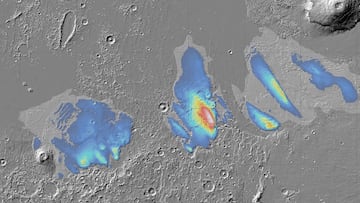Scientists discover frozen water on Mars that could cover the entire planet
The European Space Agency has found evidence of a huge ice deposit under the equator of the red planet. The amount of water could cover its entire surface.

For years, space exploration has focused much of its resources on Mars. The red planet was believed to meet the optimal conditions to host life, but it has been difficult to find evidence to support this theory. The different space agencies have been trying to find this proof for years: powers such as China and the United States, through NASA, have sent a rover to the Earth’s neighbor to conduct this research.
The European Space Agency (ESA) has now found large amounts of frozen water under the equator of Mars. The Mars Express, sent to the planet in 2003, had already found this location 15 years ago, when it spotted the Medusae Fossae Formation (MFF). There it found massive deposits, one and a half miles deep. However, it was not possible to determine what these deposits were made of at that time.
READ ALSO: This is what a nuclear explosion would look like when seen from space
The ESA has managed to determine more precisely the size of this discovery, and the news is even better: there is a huge amount of water in these deposits, and in large quantities. The thickness of the water was even greater that previously thought, as it reaches 2.3 miles.
“We have explored the MFF again using more recent data from the Mars Express MARSIS radar, and we have discovered that the radar signals are similar to the signals we see from the polar caps of Mars, which we know are very rich in ice,” explains Thomas Watters of the Smithsonian Institution and lead author of the study.
An important area for Mars exploration
The amount of frozen water found under the subsoil of Mars is so much (between 53,000 and 95,000 cubic miles) that, if it were to thaw, it could cover the entire planet with a layer five to nine feet deep. That amount of water would be enough to fill the Red Sea on our planet, and it is more than all the fresh water in rivers and lakes on Earth combined. According to the ESA, these figures could represent the largest amount of water ever detected in this region of the red planet.
The initial observations already gave indications of what was finally discovered: the MFF was relatively transparent to radar and of low intensity, two characteristics typical of ice deposits. But the experts did not want to rule out that they could be accumulations of dust, volcanic ash or sediments.
“Given its depth, if the MFF were simply a giant pile of dust, we would expect it to compact under its own weight,” says Andrea Cicchetti of Italy’s National Institute of Astrophysics.
The news of the discovery is also important for future missions since the amount of water, its extent and location are vital. NASA hopes to take astronauts to Mars by 2040, and if they finally land, they would be near the planet’s equator, far from the polar caps and high-latitude glaciers.
However, for the moment it will be difficult to get access to that frozen water, as it is covered by hundreds of meters of dust.
“This makes them inaccessible for at least the next few decades. However, each piece of ice we find helps us build a better picture of where Mars water has flowed before, and where it can be found today,” ESA explains.
READ ALSO: Another Arctic blast to spread across central to eastern US
A less arid past
Thanks to the images that come to us from Mars, we see a landscape similar to a desert, although the surface has clues indicating that in the remote past water was abundant. Canals, dry rivers, ancient ocean beds and valleys carved by the water that once flowed through them indicate that, long ago, it was a planet more similar to Earth.
With the current climate of Mars, these ice deposits could not have been generated in any way.
“They are suspected of hiding beneath the dry surface of the MFF. They must have formed in a previous climatic epoch,” notes the ESA.
This is a new analysis that “challenges our understanding of the Medusae Fossae Formation and raises as many questions as it answers,” says Colin Wilson, ESA project scientist for Mars Express.
“If confirmed to be water ice, these massive deposits would change our understanding of the climate history of Mars,” he adds.





